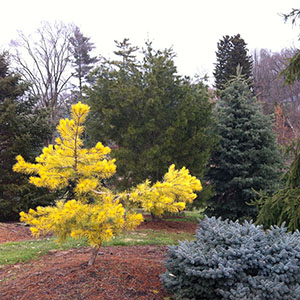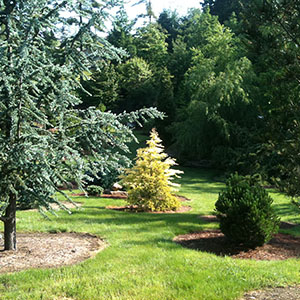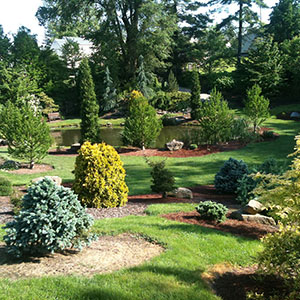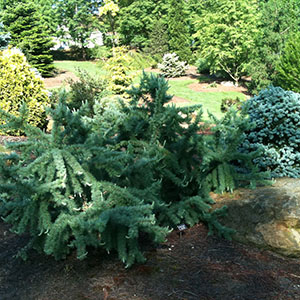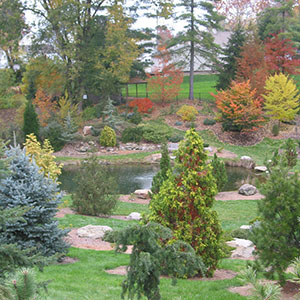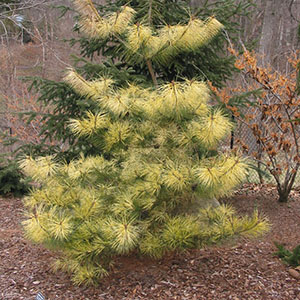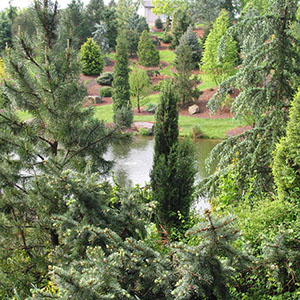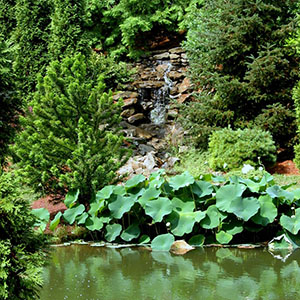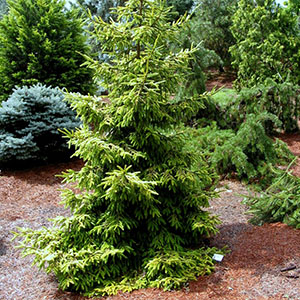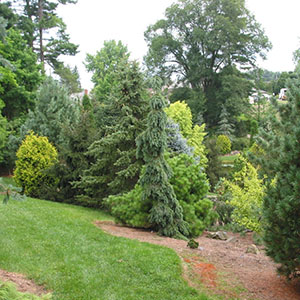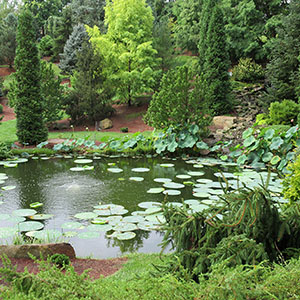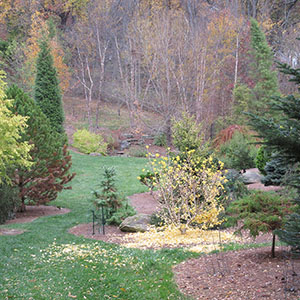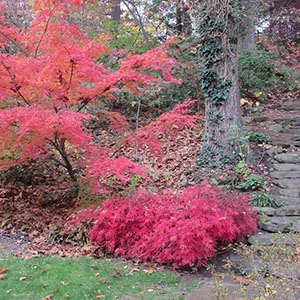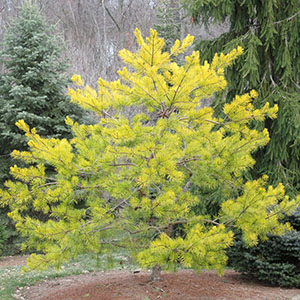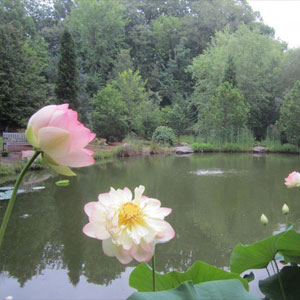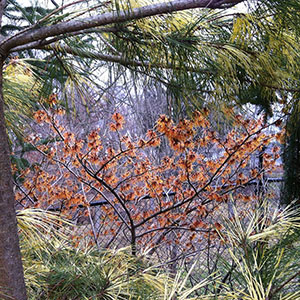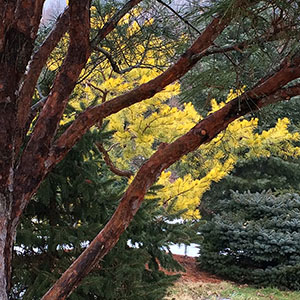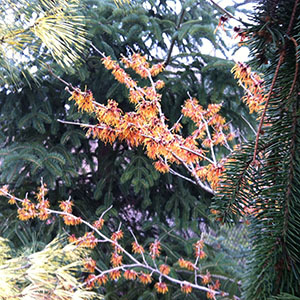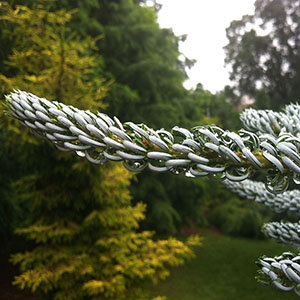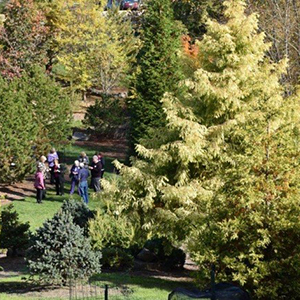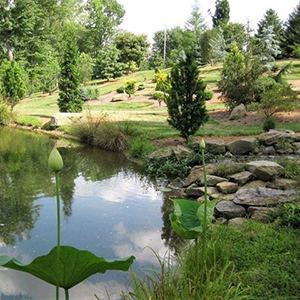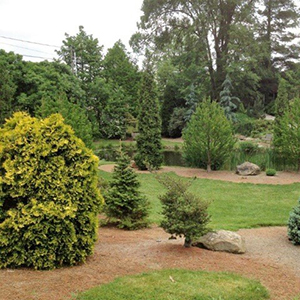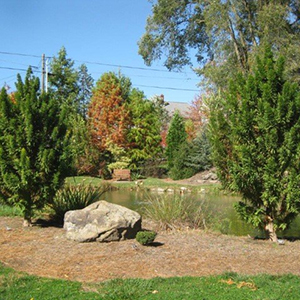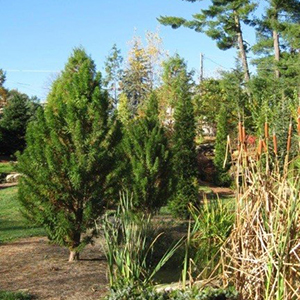Conifer Grove
The Mission Oaks Gardens Conifer Grove is located in a residential neighborhood in Zanesville, Ohio. It is a large and widely varied collection of conifers, and also contains numerous unusual broad-leaved trees. The grove is located in a secluded serene setting with a waterfall, pond and benches that provide an ideal setting for relaxing, calming the spirit, and appreciating the beauty of nature.
Conifer Grove Diversity
The Conifer Grove contains more than 200 conifers and 70 non-conifers that are native to many continents and climatic environments.
The conifers represent nearly 60 species within 22 genera, which is nearly one-third of the 68 conifer genera recognized worldwide. The wide diversity is partially attributable to the presence of the contrasting clay and well-drained soils and also the adventurous planting attitude of “let’s try it.”
The genera Picea (spruce) and Pinus (pines) are well represented in the grove due to their world-wide diversity and number of species. But there are also many examples of less well-known genera including Cryptomeria, Cunninghamia and Thujopsis. Appearance wise, all CONifers have CONes. In addition, conifer trees have needles, or sometimes scales or awls, in lieu of broad leaves found on oaks, maples, ashes, etc.
The 70 non-coniferous trees represent 42 species and 31 genera. The Conifer Grove includes numerous pure species of trees, but there are also many natural and cultivated varieties that demonstrate the large variances within a single species.
A list of the trees in the Conifer Garden is available from the Muskingum Valley Park District located at 1720 Euclid Ave., Zanesville, OH 43701. (740) 455-8237.
Development of the Conifer Grove by the Mission Oaks Foundation began in 2003 after two private parcels were purchased and the city opened the alley from Hunter Street into the grove.
Preparation of the area required removal of many truckloads of trash. A large storm sewer ditch was replaced with a buried pipe, and then the pond and rustic waterfall were constructed.
Planting of trees in the Conifer Grove began in 2004, and the grove was first opened to the public in 2005.
On the path into the Conifer Grove from Hunter Street a few pieces of clay tile are still visible. This northwest bank was a tile shard dump used by the AE Tile Company in the 1920’s. This extensive base of tile, covered by a shallow layer of soil, provides an excellent planting site for plants that require well-drained soil. “Well-drained soil” is rare in the Zanesville area, which used to be noted as the pottery capital of the world due to the high clay content of the soil.
Conifer Grove Volunteer Partners
Muskingum Valley Park District
Muskingum County Master Gardeners
Muskingum Valley Garden Society
Schroeder Dodds, Conifer Grove project consultant and forester
Jeff Bowman, conifer consultant and curator of the Dawes Arboretum conifer collection
Mapping Out Nature
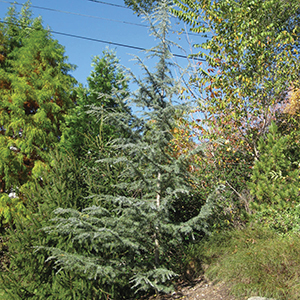
Deodar cedar, Cedrus deodara (#211/#217)
As you walk into the grove from Hunter Street there are two beautiful deodar cedars on your right above the pond. With your back to the pond, the one on your left is variety ‘Karl Fuchs’, and the one on the right is variety ‘Shalimar’. They shouldn’t be beautiful and healthy in this locale. They prefer hardiness zones 7 to 9, but they are doing well here in hardiness zone 5/6 due to the excellent drainage provided by the tile dump and the southern exposure.
These true cedars are native to the western Himalayas in Afghanistan to western Nepal, but this variety hails from Pakistan. This variety grows to 40’ to 70’ in height.
This variety is noted for its narrow, pyramid form and striking bluish color.
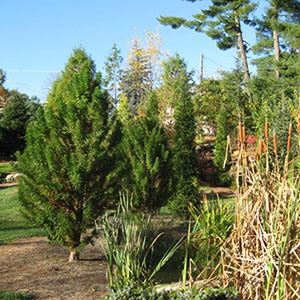
Baldcypress, Taxodium distichum ‘Peve Minaret’ (#501)
Beside the pond is a baldcypress that has green needles for eight months during the year, but the needles turn orangey brown in the fall, and then fall off leaving the tree leafless during the winter, demonstrating that not all conifers are 'evergreens', but are 'deciduous' like most broad leafed trees. Baldcypress trees normally grow in swamps, and they are noted for the 'knees' that stick up above the water or ground level from the roots. The brownish knees are visible growing under the tree.
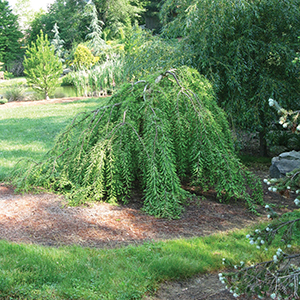
Bald cypress, Taxodium distichum ‘Cascade Falls’ (#603)
Beyond the pond, on the left near the fence, is another baldcypress variety Taxodium distichum ‘Cascade Falls’, but it is a weeping variety, in lieu of growing upward in a conifer shape. Behind the baldcypress is a pondcypress, Taxodium ascendens, and to the right of that is a dawn redwood, Metasequoia glyptostroboides. Although the baldcypress trees closely resemble dawn redwood trees, the baldcypress trees have an alternate branching leaf and leaflet pattern, while the dawn redwood has an opposite leaf pattern (similar to your arms coming out from your shoulders opposite each other).
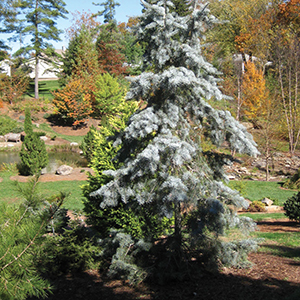
White fir, Abies concolor (#802)
Continuing up the hill on the path you will see an unusual 'white' fir on your right. It should be called 'long needled silvery blue' fir. It is a striking tree with unusually long and bluish needles. White fir is native to the mountains of the western United States. White firs also are excellent 'Christmas trees,' since they hold their needles for several weeks, unlike spruce trees.
The needles on firs are 'flat and friendly' and tend to grow upwards. In contrast, spruce needles are square in cross-section (roll one between your fingers), and they are sharp on the needle tip (not friendly). You passed a small spruce tree on your right as you walked from the path to the fir tree. Grab a branch of the fir tree, and then grab a branch of the spruce tree, and you will feel the difference.
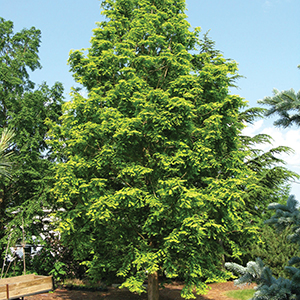
Dawn redwood, Metasequoia glyptostroboides ‘Ogon’ #728)
From most anywhere in the grove you can look up the hill to the southwest toward the greenhouses, and this magnificent dawn redwood will stand out. Its beautiful new growth is sunshine yellow, in contrast to the older needles that are a darker rich green.
Dawn redwoods were thought to have become extinct 10,000 years ago. However, a small grove of living trees was accidentally discovered in China in 1941. Samples were collected and distributed to several universities in 1945/6. The tree has been widely cultivated and planted worldwide since then. Dawn redwoods are deciduous, so they lose their needles in winter and recover their beautiful appearance in the spring.
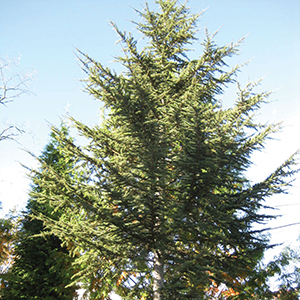
Cedar of Lebanon, Cedrus libani ‘Stenocoma’ (#723)
Adjacent to the ‘Ogon’ dawn redwood is a beautiful specimen of cedar of Lebanon. This is another true cedar in contrast to the majority of trees that are called cedars, but are actually junipers or members of other genera.
This species is native to the Mediterranean area, and is most widely known as being one of the few trees specifically named in the Bible.
The tree is the national emblem of Lebanon and is displayed on the Lebanese flag.
The species can exceed 100’ in height. Unlike most conifers, the cones grow upright.
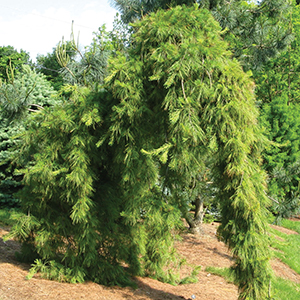
Eastern white pine, Pinus strobus, ‘Pendula’ (#717)
Moving down the path back towards the pond is a very unusual droopy looking tree on your left that somewhat resembles an elephant, including a trunk. The shape of this pendulous eastern white pine doesn’t resemble the white pines that grow in Ohio forests, or even the white pines that are on the western border of the Conifer Grove, but it is the same species. This special variety has been cultivated to grow in a drooping shape. Seeds from this tree will produce trees that have a weeping form, but they probably wouldn’t look like an elephant.
-
Mission Oaks Garden
Hunter Ave., Zanesville, OH 43701
740-450-8050
